History of WU
From the Imperial Export Academy to a Modern-Day University
The foundation of the Imperial Export Academy was driven by the vision to train trade experts in a novel way. Already back then, internationality was a core value. And this has not changed. WU is a modern and innovative university. Internationality, inclusion, and responsibility are important to us. Let us take you on a trip down memory lane and show you the ways in which WU has assumed its social responsibility.
WU from Then until Now
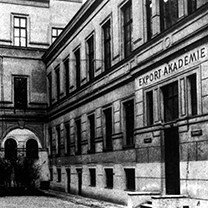
Foundation of the Imperial Export Academy
At the turn of the 19th century, there was no education for qualified merchants in Vienna. To address this shortcoming, the Viennese Merchants Guild actively promoted the foundation of the Imperial Export Academy.
Thus, WU’s predecessor was established on 1 October 1898. Until 1915, the academy belonged to the Austrian Trade Museum. After that, it was run by an association. During the initial years, the Imperial Export Academy also shared a building with the Trade Museum, the Palais Festetics at Berggasse street in the 9th district.
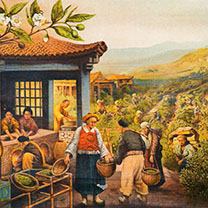
A New and Visionary Education
Education at the Imperial Export Academy was visionary, offering a great variety of practice-oriented courses on commerce-related subjects and trade goods as well as economics, economic geography, and public and private law.
Right from the start, courses were oriented towards internationality. Graduates were highly qualified for trade within the monarchy as well as with other countries and continents. Business languages were thus mandatory.
Even the idea of “life-long learning” was already promoted by the Imperial Export Academy. In addition to the regular course of study, there were special courses for professionals of certain industries and sectors.
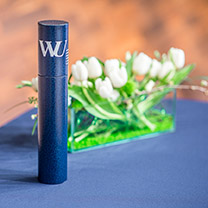
First Female Graduate
Anna Baidaff studied at the Imperial Export Academy from 1914 to 1917. She was the first woman to graduate from WU’s predecessor and thus also the first woman licensed to use the title of “qualified merchant.”
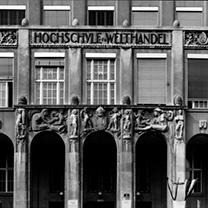
Relocation to a Bigger Building
Students flocked to the Imperial Export Academy in great numbers. Soon, it outgrew the building at Berggasse street.
Before the beginning of the First World War, it was decided to erect a new building bordering Währing Park in the 19th district of Vienna. The grand opening was on 20 March 1917.
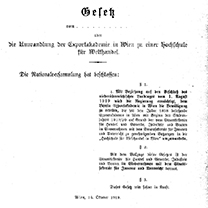
Imperial Export Academy Becomes University of World Trade
There had been plans to grant the academy the legal status of a university already during the monarchy. In 1919, the Imperial Export Academy finally became the University of World Trade.
From then on, a rector headed the institution instead of a director, flanked by a team of professors as it was custom at universities and other colleges in Austria. However, it was not until much later that the university was able to confer academic titles. In 1930, it was granted the right to award doctoral degrees; in 1936, a decree was passed stating graduates would receive the academic degree of Diplomkaufmann.
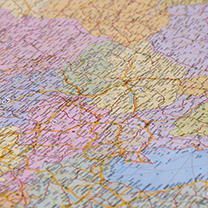
In High Demand in Austria and Abroad
The University of World Trade was a meeting place for students from all over the new Republic of Austria and the successor states of the Habsburg monarchy.
The students from abroad at times doubled or even tripled the number of Austrians, making for an impressively international atmosphere.
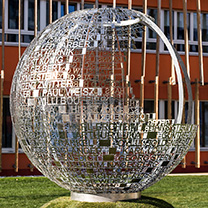
Years under Nazi Rule
Many of the students at the Export Academy and University of World Trade were Jewish. They experienced hostility, discrimination, and violence already in the 1920s and 1930s.
With Austria’s Anschluss to the German Reich on 12 March 1938, antisemitism at the university reached its peak. Within just a few weeks, Jewish students, employees, and faculty members were forced to leave. Staunch supporters of the Austrofascist regime were expelled as well. In their place, lecturers from Austria and the Third Reich who were loyal to the new regime were appointed, and Nazification also provided career opportunities for National Socialist academics at the University of World Trade.
From the beginning of the Second World War, also nationals of so-called “hostile states” were excluded from studying at the university. Several members of the university were murdered in the Shoah. Students who, in the eyes of the racist regime, were thought of as members of a “mixed race,” were subject to bureaucratic arbitrariness. In four cases, the university stripped graduates of the academic degrees they had been awarded in the First Republic, demonstrating the racist and politically motived persecution during the Nazi rule.
Following the adoption of German-centric study regulations, foreign languages lost their status as mandatory test subjects. With its Südost-Stiftung des Mitteleuropäischen Wirtschaftstages Berlin zur Heranbildung junger Kaufleute für Südost-Europa (South-East Foundation of the Central European Economic Council of Berlin for the Education of Young Merchants for South-East Europe), the University of World Trade also benefited from Nazi imperialism during the Second World War.
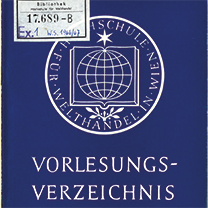
An Era of Modernization
The reverberations of the Nazi regime were palpable for decades to come – also at the University of World Trade. For example, the economic and social theories stemming from corporate statism, developed in the 1920s and 1930s, continued to be taught.
With the foundation of new institutes for, e.g., sociology, economic sociology, mathematics, and statistics, the University of World Trade transitioned into a modern university in the 1960s. Academic research and teaching were now measured against international standards. In 1966, this development led to the introduction of degree programs in social sciences and economics: retail and trade, business administration, economics, and business education. Graduates of the by now eight-semester diploma program were awarded the degree of Magister, and doctoral graduates received the title of doctor of social and economic sciences.
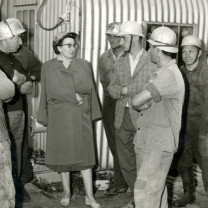
Margarethe Ottillinger Joins OMV Executive Board
From 1957 until her retirement in 1982, University of World Trade graduate Margarethe Ottillinger served on the OMV Executive Board. She was the first woman in this position and helped OMV become the paragon of an Austrian company it is today.
Margarethe Ottillinger completed her studies at the University of World Trade in 1940. In 1941, she earned a doctoral degree with her dissertation on “The Danube: Greater German Waterway and Transit Route to the Middle East.” In 1942, she was appointed head of the statistical office of the iron department of the German government’s southeastern branch office. After the war, she worked as a top civil servant consulting on economic questions under the Minister for Asset Protection and Economic Planning, Peter Krauland. In 1947, she took over as head of the planning department. A year later, Ottillinger, aged 28 years at the time, was arrested by Soviet border guards out of the minister’s car, who stood idly by, under circumstances that have never been fully explained. She was then brought to Moscow and sentenced to 25 years of forced labor. Margarethe Ottillinger spent seven years imprisoned in Stalin’s gulag camps before returning to Austria after the conclusion of the Austrian State Treaty. One year later, she was rehabilitated by the Supreme Soviet.
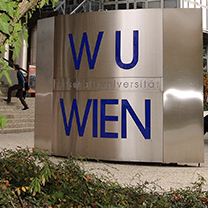
New Name: Vienna University of Economics and Business
The 1970s were a time of pronounced democratization. In 1975, the University of World Trade became the Vienna University of Economics and Business.
Decisions were no longer made exclusively by a team of professors; junior faculty and student representatives also had a say from then on.
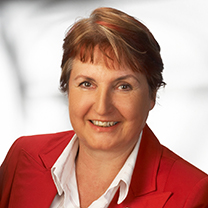
First Female Professor Appointed at WU
In 1981, sociologist Gertraude Mikl-Horke was appointed as the first female professor at WU. She was also the first woman to earn a venia docendi at WU (1977).
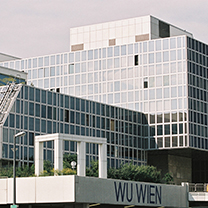
Opening of the Campus in Althanstrasse
Studies at WU have always been innovative and international, which is why the number of first-semester students increases every year. In the past 125 years, student numbers have continually grown.
By the 1970s, the number of students had already outgrown the university’s building. This initiated the construction of the university campus in Althanstrasse in the 9th district. Opened in 1982, it was already packed to full capacity shortly after the turn of the millennium.

Focus on Internationalization
In the 1980s and 1990s, WU defined global cooperation in research and teaching as a strategic cornerstone.
The International Office was created in 1990. To this day, it supports the international mobility of both students and teaching staff.
That same year, WU joined CEMS, a network of universities founded shortly before. In the years to come, WU became a member of the most essential international networks of higher education. Today, students, teachers, researchers, and staff who want to complete a stay abroad can choose from about 240 partner institutions.
Since 1992, WU has also taken part in the ERASMUS/SOCRATES program, which facilitates exchange within Europe and offers scholarships.

Gender Equality Picks up Pace
After a legal amendment in 1990, universities were obligated to create an Equal Opportunities Committee (EOC). The foundation of the EOC at WU in 1991 was a big step towards gender justice.
The next year, WU adopted a Plan for the Advancement of Women, which to this day remains part of its by-laws. Its impact became visible for the first time in the study year of 2002/03: WU employed more women than men. The same year, WU created a chair for Gender and Diversity in Organizations. Edeltraud Hanappi-Egger, who has held this position since then, also became WU’s first female Rector in 2015. In 2014, the staff unit for Gender & Diversity Policy was established.
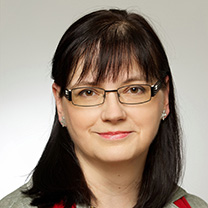
First Female Vice-Rector for International Relations
In the 1990s, internationalization became more and more important at WU, which was emphasized by the appointment of a Vice-Rector for International Relations. Linguist Gerlinde Mautner took on this position.
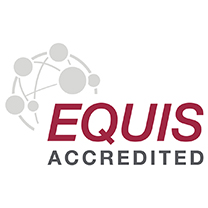
International Recognition: EQUIS Accreditation
In February 2007, WU received the renowned EQUIS (EFMD Quality Improvement System) quality seal by the recognized European Foundation for Management Development (EFMD) agency.
The EQUIS accreditation was WU's first of by now three international accreditations (EQUIS, AACSB, AMBA).
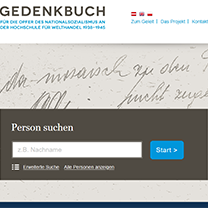
Research on the University’s Past under Nazi Rule
WU has investigated the role it played under Nazi rule to face its history.
WU’s Commemorative Project examines the fate of the members of the University of World Trade who were persecuted for political and/or racist reasons. Their biographies have been collected in a virtual, online memorial book.
Another visible sign of commemoration is the memorial installed at the Campus WU: The names of the displaced members of the University of Trade were connected to form a globe. The gaps in between allude to the gaps left by these people. Whenever WU becomes aware of another displaced person, they can be included in the memorial. This way, at least the memory gaps can be closed.
As part of a comprehensive provenience study, the University Library is analyzing how books printed before 1945 came to be in its possession. Any books added to the library as a result of politically or racially motivated persecution are restored to the legal owners or their legal heirs.
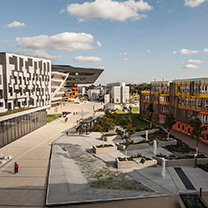
A Campus for the Future
Shortly after the turn of the millennium, student numbers had outgrown the university campus on Althanstrasse, opened in 1982.
A campus to dwarf all others was thus designed to be constructed on the area of the 1873 Vienna International Exhibition in the 2nd district. International top architects were invited to enter a design competition to develop a vision of a university of the future together with WU.
On a surface of about 100,000 square meters, an accessible and sustainable campus was created, which has offered WU members optimum work and study conditions since 2013. Campus WU is more than just a place of research and teaching. It encapsulates social, cultural, and political life.
Slightly more than half of the area has been turned into a park accessible to the public. Visitors are welcome at all times.

Among the World’s Leading Business Schools
WU strives to be among the leading business schools in both teaching and research. Three renowned international accreditations certifying WU’s high quality standards are proof that WU has accomplished this goal.
Since 2015, WU has held the renowned triple accreditation: EQUIS, AACSB, and AMBA. This means that it belongs to an exclusive circle of only eight universities in the German-speaking region and just below 1% of universities worldwide boasting this distinction.
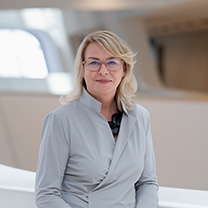
First Female Rector
Edeltraud Hanappi-Egger became WU’s first female Rector in 2015. Back in 2002, she had been appointed as the newly created chair for Gender and Diversity in Organizations.
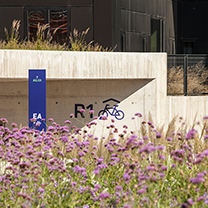
Austria’s First Climate-Neutral Campus
As a public institution, WU was committed to its responsibility to design its new campus in an economically, ecologically, and socially sustainable way.
The university focuses on a frugal and efficient use of resources and a conscious use of materials in its daily operations. For these efforts, Campus WU has already received many awards. The buildings are accredited “Blue Buildings” (even exceeding the standards of “Green Buildings”) and their operations are certified according to EMAS and ISO 14001. Nevertheless, CO2 emissions cannot be fully prevented during ongoing operations.
WU compensates for carbon emissions that cannot by avoided by supporting national and international climate protection projects.
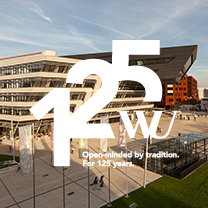
WU Turns 125
Today, WU identifies as a university that takes its social responsibility seriously, which is reflected in all its actions.
Its excellence, diversity, and responsible decision-making are widely known and its pioneer achievements lauded time and again.
WU was the first Austrian university to establish a professional Career Center, recognize the importance of alumni networking, implement the Bologna study architecture, and apply for international accreditations.
The development of innovative teaching and research is characteristic for WU. The WU Campus with its unique architecture and modern infrastructure is proof of the university’s innovative power and its excellent international network. The creation of the first English-taught Bachelor’s program in Business in Austria and WU’s contribution to building a European University are the newest examples showing how the university has excelled in its role as an academic pioneer time and again.
Also in the future, WU will remain true to its role as a trailblazer. Consistently attuned to the latest developments, it will continue to contribute to solving economic, ecological, social, and legal problems in the years to come, promoting economic performance and social prosperity in its wake.